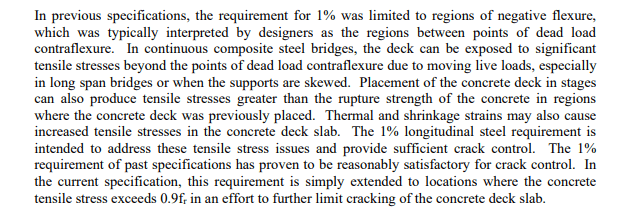tmalik3156
Structural
Good day.
Suppose we have a multi-span continuous bridge deck. We need to provide negative steel to the deck on both sides of the pier. The question is how far from the pier should we terminate the negative steel?
1. Draw dead + superdead load moment diagram. Terminate negative steel at the point of contraflexure.
2. Same as 1 but extend a little more to include development length.
3. Use dead + superdead + live load moment diagram, and terminate at the point of contraflexure (or extend to include development length)
Can someone please provide me a reference (Code) on what is the correct method? I have heard from other people, but I need solid reference.
Personally, I would go with 2., but I cannot explain it properly.
Also, if you follow a thumb rule, please share.
Thank you
Suppose we have a multi-span continuous bridge deck. We need to provide negative steel to the deck on both sides of the pier. The question is how far from the pier should we terminate the negative steel?
1. Draw dead + superdead load moment diagram. Terminate negative steel at the point of contraflexure.
2. Same as 1 but extend a little more to include development length.
3. Use dead + superdead + live load moment diagram, and terminate at the point of contraflexure (or extend to include development length)
Can someone please provide me a reference (Code) on what is the correct method? I have heard from other people, but I need solid reference.
Personally, I would go with 2., but I cannot explain it properly.
Also, if you follow a thumb rule, please share.
Thank you




